TWO more portions of the huge wall painting from Yüeh Shan Ssŭ, near Ch’ing Hua Chen, have recently been acquired by the UNIVERSITY MUSEUM and are now reunited with the rest of the Kuan Yin wall, to which they both belong. The major part of this huge fresco was purchased in 1926 and was published in the MUSEUM JOURNAL for September of that year although several important parts of the painting were at that time missing and it could not then be ascertained where they were, or indeed that they had not been destroyed either during removal or in transit. The loss most seriously felt was that of the portion of the painting which contained the figure of the great seated Bodhisattva which should have appeared on the right side of the colossal central Buddha, to match that of Kuan Yin on the left. It is therefore most fortunate that this particular section, measuring over fifteen feet high and five and one half feet wide and belonging to the central part of the composition, should be one of the parts just acquired. The other is a smaller fragment, two feet wide and about five feet high, which, however, fills a keenly felt need on the other side of the wall and is, moreover, most interesting because of its subject. The acquisition of these hitherto missing parts has made it possible to put all the sections together and mount them as one immense wall over thirty feet long and eighteen feet high. The newly acquired sections may be clearly made out in the picture of the whole wall here reproduced for they appear fainter than the rest, due to the fact that they have not yet been cleaned. Their importance in the composition is here fully evident. There are still small fragments missing from along the edges but the central and main part of the design is practically complete. The MUSEUM now possesses almost in their entirety the two side walls of the great hall of a famous Buddhist temple. The opposite wall was purchased in the latter part of 1927 and was published in the MUSEUM JOURNAL for June 1928. Each wall is most impressive, with its tremendous enthroned Buddha in the centre, the colossal Bodhisattvas seated European fashion on either side, and the lesser Bodhisattvas, minor deities, devas, child devotees, and other figures grouped around. The paintings are in a fine state of preservation except that the surface is marred by innumerable pittings and scratches. Only at the bottom of each wall, however, has this surface been actually defaced, due doubtless to the dampness, and rubbish accumulating on the floor of the old temple.
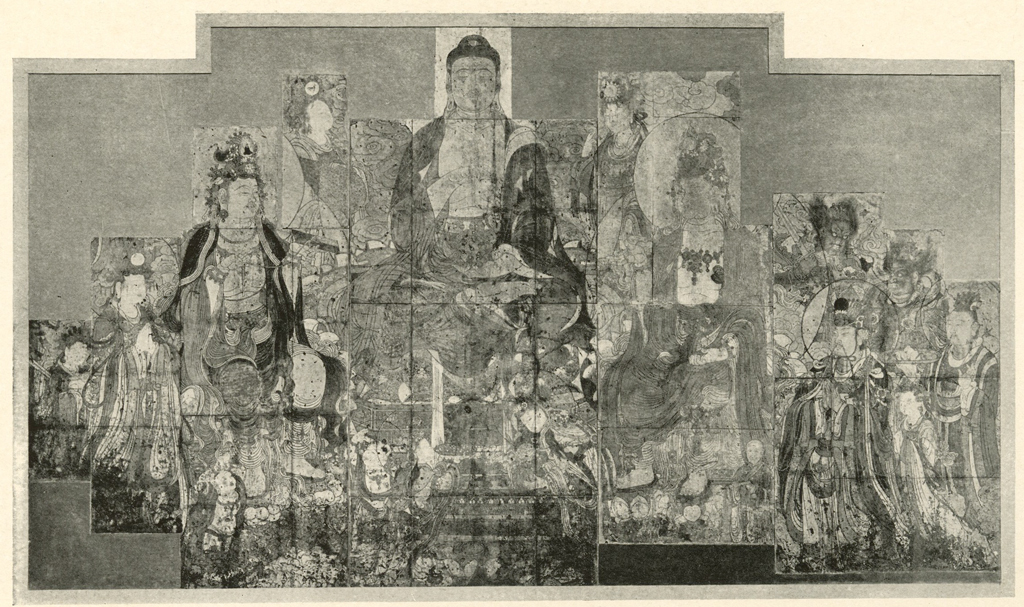
Museum Object Numbers: C492, C493, C494, C495, C692
Image Number: 1443
As has been stated elsewhere, these paintings are not in the technique of true fresco but have been executed in some sort of tempera and the colors show certain enamel-like qualities. Chemical analysis will probably reveal the nature of the medium and explain why the black used for outlines is not so well preserved as are the blues, tans, emerald greens, and reds.
Considered even quite by itself and not as a mere part of a larger composition, the more important of the two recently acquired pieces of fresco is tremendously impressive. It shows the huge figure of a seated Bodhisattva over twelve feet high, with opaque halo behind the head and transparent halo around the body. The feet are firmly planted upon lotuses. The left hand, in peculiarly distorted drawing, lies palm upward upon the left knee while the right hand is raised in a variety of the vitarka mudrā, the attitude of exposition or argument. The whole figure is turned slightly inwards toward the central Buddha. Near the right shoulder may be seen the graceful form of a fair Bodhisattva wearing in the front of her headdress the disc symbolic of the moon, with points all around the circumference of it. In this moon disc, faded and defaced but still unmistakable, is a figure which certainly looks more like a monkey than the usual hare. This little Bodhisattva holds a scroll in her slender left hand. Her right hand and arm were on the great central section containing the Buddha which had already been in the MUSEUM for three years so that one of the most satisfactory results of the reunion of these hitherto missing parts with the whole has been the restoration to its proper owner of this severed right arm. A third figure appearing on this panel is that of a Buddhist priest who stands in the lower right corner holding a scroll.
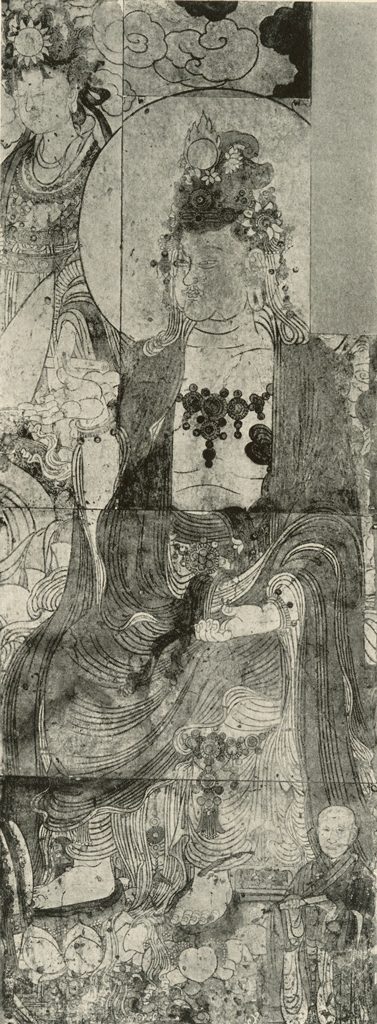
Museum Object Numbers: C692.2, C692.3, C692.4, C692.5, C692.6
As in the rest of the painting the flesh tones and many details of the background are a warm tan color. But this Bodhisattva is robed in a garment of glorious light green which is in striking contrast to the deep red of Kuan Yin’s robes on the other side. The green is more yellow than the emerald seen in other parts of the painting. The blue scarf over the right arm and the mulberry coloured girdle, the green, blue, tan and gold of headdress and jewels, are all in a harmony which fits perfectly into the color scheme as a whole and tends to make the rich red of the Buddha’s robe even more intense. And again is demonstrated that marvellous craftsmanship, that mastery of line which tells of a sure swift hand and an unerring eye, a love of rhythm and a joy in the quality of the line itself.
The smaller fragment fits down into a space on the other side of the painting above the Kuan Yin’s left shoulder. It shows the little Bodhisattva of the Sun, the companion to her of the Moon opposite. In the front of her elaborate headdress appears the plain sun disc with the figure of the three legged crow in it and on her arm she carries a p’i-p’a, or guitar, ornamented with a starry pattern. Both she and the Moon Bodhisattva are in prevailing soft cream tones with merely touches of green, of dull gold, and of mulberry.
On the lower part of the larger panel, as is the case all along the bottom of the two walls, appear at about shoulder height a number of characters scratched or written upon the painting by pilgrims to the temple. Most of the characters on the newly acquired section are so defaced that it is quite impossible to make them out but three or four can be deciphered, ya—duty, chia—home, mu—wood, and chê—an empty word which may have been part of a name. There is no inscription which may give a clue to the date of the painting.
However, it is probably but a matter of time now before these great frescoes from Moon Hill Monastery may be dated with certainty. The Chinese Division of the Library of Congress, in charge of Dr. Arthur Hummel, has been making an extensive collection of the local gazetteers, or district records, of China, known as the Fu Chih and the Hsien Chih, and among them are those particular ones which concern the region in which is located Moon Hill Monastery. Dr. Hummel has been most kind in offering every facility for the search of these records.
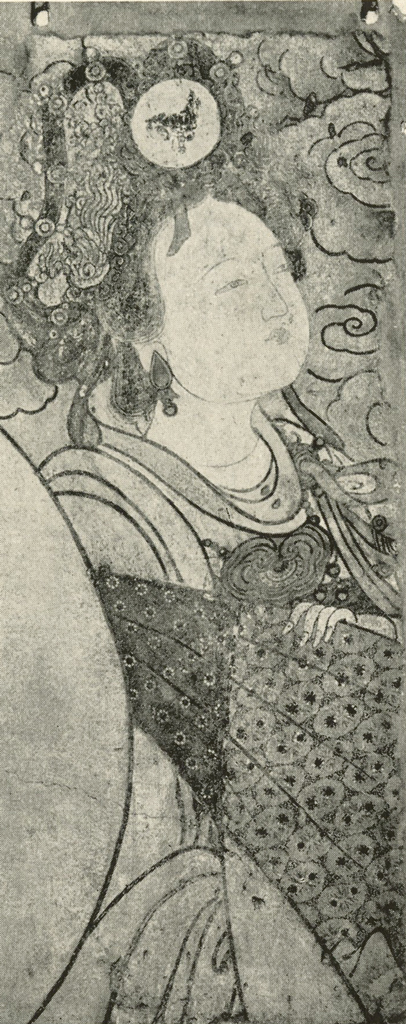
Museum Object Number: C692.1
Image Number: 1468
Moon Hill Monastery is a very famous temple of Honan Province. It is located in the Fu (county) of Huai Ch’ing, and in the Hsien (district within the Fu) of Ho Nei. It appears upon maps both in the Huai Ch’ing Fu Chih and the Ho Nei Hsien Chih. Two of these maps from the latter work are here reproduced. The first emphasises the mountains of the district. Above the plain, where lie the Fu city of Huai Ch’ing (■ ■ ■) and the little market town of Ch’ing Hua Chen (■ ■ ■), the mountains rise tier upon tier in a jumble of slopes and peaks dotted with temple buildings. And there on the lower slope of Bright Moon Hill (■ ■ ■) is Pao Kuang Ssŭ (■ ■ ■) now known as Moon Hill Monastery (■ ■ ■). The second map, which is primarily to show the rivers of the region, includes, however, the foothills of the mountain ranges and there again we see our monastery pictured in a grove of pine trees. In this case the building is represented as two-storied. Three maps in the Huai Ch’ing Fu Chih also show a two-storied structure, and one of the maps reveals the fact that there were several buildings in this monastery group.
From the text of these records a number of enlightening pieces of information have been gathered, which, although not proving the date of the paintings, state very important facts about the monastery itself. According to the data given in the Hsien record under ” Ancient Remains ” this monastery was built in the 21st year of the Ta Ting reign of the Chin Dynasty (1181). In another section, that on “Hills and Rivers,” we are told that the builder was the Buddhist monk K’ung Hsiang. The name first conferred upon the temple was Ta Ming Ch’an Yüan (great Bright Zen-Buddhist Hall), but in the Yüan Period this name was changed to Pao Kuang Ssŭ (Precious Light Monastery). In the 3rd year of the Yung Lo Period (1405) the place was repaired. Now it goes by the name Yüeh Shan Ssŭ (Moon Hill Monastery).
The temple seems to be especially famous because of the visit of the Emperor Ch’ien Lung in 1750. He presented it with three pien ê (door frame tablets with eulogistic inscriptions) and a pair of Tui lien (pillars inscribed with a matched couplet). The passage may be translated thus:
“The Yuan Yin Halle ê said:
“‘Compassionate thoughts are let fall like the clouds.’
“The P’i Lu Hall ê said:
“‘The six Abhidyña1 completely surround us.’
“The Shui Lu Hall ê said:
“‘(Behold) inexhaustible glory and brightness.’
“The Buddha Hall tui said:
“‘The meritorious virtue of the waters of Chou encircle thee bearing the bright moon’s reflection,
“‘The peaceful clouds float in the clear precious sky, like streamers of incense so subtly waving.'”
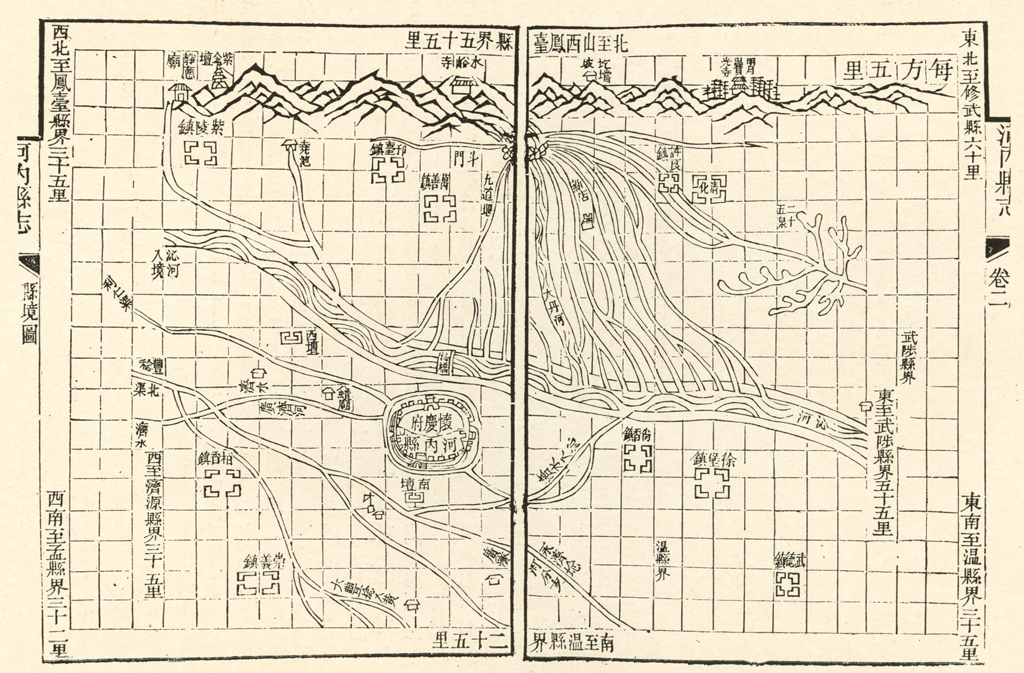
The Hsien record continues with the quotation of other poems by famous visitors upon the beauties of Moon Hill Monastery. Un-fortunately their praises consist in eulogies of the view and do not mention the paintings within the temple. Of special interest, how-ever, is the fact that a part of the description given there is said to be a quotation from the ” Pao Kuang Ssŭ Chi of the Yüan Period, ” thus indicating the existence of old Temple records. Such records doubtless contain all the desired data as to the paintings and one may hope to have access to this material some day in the future. The Huai Ch’ing Fu Chih contains mainly a repetition of the material in the Hsien record, but mentions one fact not given there, namely, that in the Yuan Period the Emperor T’ai Ting (1324-28) built (a hall?) here.
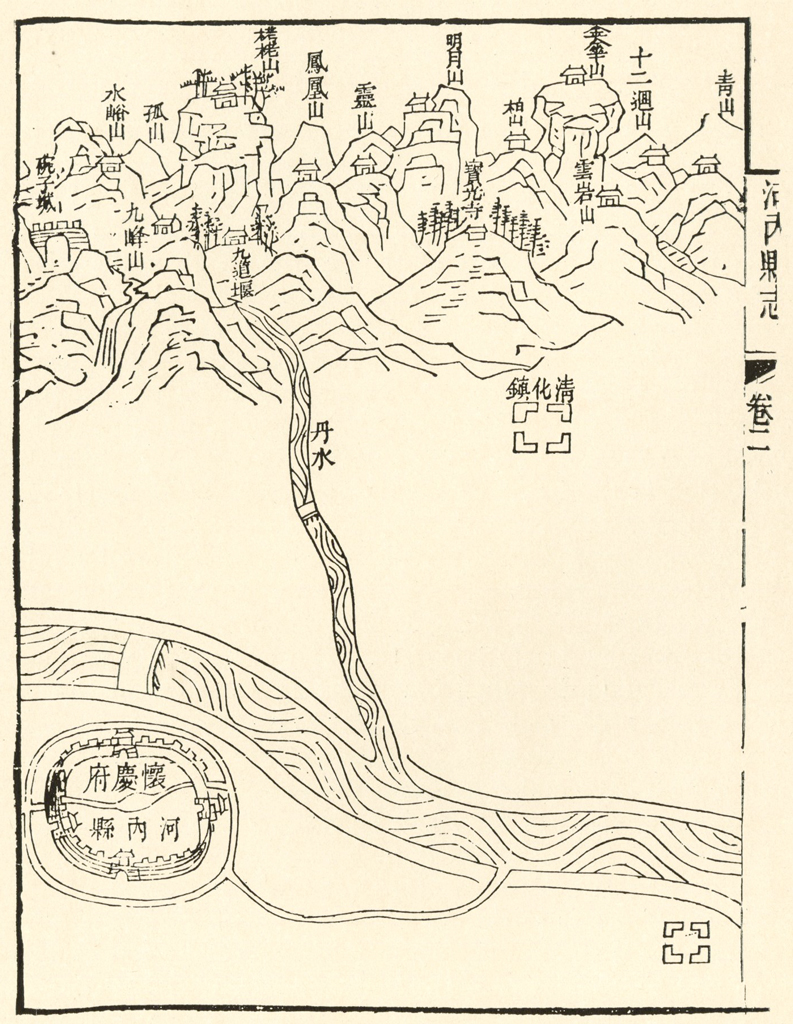
Thus we may, definitely abandon the tenth century hypothesis for the date of the paintings, as it would appear that the monastery was not yet built in the T’ang Dynasty and our first information as to that was evidently incorrect. The monastery was founded in the Sung Period, in 1181, some building was done in the Yüan Period about 1325, and, finally, the monastery was extensively repaired early in the Ming Dynasty, in 1405, to be exact.
In composition and conception the paintings from Moon Hill Monastery are typical of the T’ang Dynasty although such emphasis upon line design is not known to be a characteristic of that period. As I stated in the MUSEUM JOURNAL for June, 1928, it seems unlikely that frescoes of this style should have been painted in the Sung Dynasty when the decidedly feminine conception of bodhisattvas was so popular—”more likely that they are Ming—if the tenth century hypothesis proves untenable”. Early in the Ming period there began that revival of the old T’ang art which would account for the T’ang design and the masculine form of the bodhisattvas. And it may be noted that in the item concerning the repair of the monastery in the third year of Yung Lo the character hsiu is used, a term which implies repairs so extensive as to mean almost a rebuilding.
The two beautiful wall paintings from Moon Hill Monastery are therefore in all likelihood works of the early Ming Dynasty executed according to the T’ang tradition. The temple records themselves have yet to be examined but the evidence of the local Hsien and Fu records, embodying material that had been handed down in earlier editions for several hundreds of years, certainly seems to suggest 1405 A. D. or soon after as a very probable date.
1 The six supernatural faculties.↪

